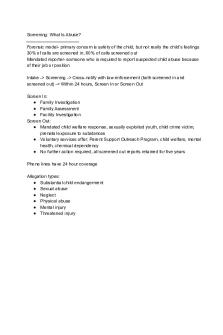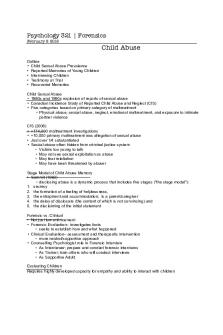SW3701 Interventions for Child Sexual Abuse lecture notes PDF

| Title | SW3701 Interventions for Child Sexual Abuse lecture notes |
|---|---|
| Course | Introduction To Child Maltreatment: Intervention And Prevention |
| Institution | University of Minnesota, Twin Cities |
| Pages | 2 |
| File Size | 47.1 KB |
| File Type | |
| Total Downloads | 95 |
| Total Views | 145 |
Summary
Professor Timothy Zuel, spring 2016 lecture notes on Interventions for Child Sexual Abuse for SW 3701 "Introduction to Child Maltreatment: Intervention and Prevention"...
Description
Interventions for Child Sexual Abuse What is trauma? ● Event ● Response ● Beliefs What is “Trauma-informed”? ● Understanding the effects of trauma on the brain and development ○ Regulation - reset (affects natural response to things) ○ Fragmentation - the story ○ Perceptions are skewed and beliefs may change ○ Learned helplessness - afraid to do things, take risks Why should trauma drive treatment? ● ensures that a child is not being re-traumatized by the therapeutic process ● unless trauma is addressed, children can go on w/o obvious symptoms and still be suffering ● impact of trauma can be experienced later in life or in new developmental stages What are we assessing? ● Conditional prior ● Developmental level ● Symptoms Complex Trauma ● When a bunch of shitty things happen to you
Sexual Abuse Symptoms ● Powerlessness (depression and anxiety) ● Stigma (social isolation or peer problems) ● Traumatic Sexualization (sexual acting out, sexual avoidance or aggression) ● Numbing (dissociation, problems with concentration, living in fantasy) Up or down ● Work from bottom or top? Phases of Treatment
● ● ● ●
Stabilization Family Engagement Process Future
Types of Treatment Approaches: ● What are the 3 most common types of treatment used with sexually abused children? ○ Trauma-informed CBT ■ focus on thoughts about self and touch ■ Goal 1: identify thoughts about inappropriate touch which are maladaptive ■ Goal 2: identify inappropriate ways to manage emotions ■ Goal 3: identify ways to manage memories and body sensations ○ Non-directive play therapy ■ seeks to create a safe haven for child ■ Allows child to have power over situation in therapeutic context ■ Encourages child to use imagination ■ Disadvantages: May never get to traumatic event ○ Body-based techniques ■ SMART (Sensory Motor Arousal Regulation Treatment) ■ EMDR (Eye Movement Desensitization and Reprocessing) ■ Sensorimotor Psychotherapy, Pesso Boyden and Somatic Experiencing ■ Disadvantage: may not buy into it...
Similar Free PDFs

ASUHAN KEPERAWATAN SEXUAL ABUSE
- 42 Pages

Child Abuse Research Paper
- 11 Pages

RA 7610 - Child Abuse Law
- 12 Pages

Child Abuse Report Form-1
- 2 Pages

Domestic Abuse Notes
- 40 Pages
Popular Institutions
- Tinajero National High School - Annex
- Politeknik Caltex Riau
- Yokohama City University
- SGT University
- University of Al-Qadisiyah
- Divine Word College of Vigan
- Techniek College Rotterdam
- Universidade de Santiago
- Universiti Teknologi MARA Cawangan Johor Kampus Pasir Gudang
- Poltekkes Kemenkes Yogyakarta
- Baguio City National High School
- Colegio san marcos
- preparatoria uno
- Centro de Bachillerato Tecnológico Industrial y de Servicios No. 107
- Dalian Maritime University
- Quang Trung Secondary School
- Colegio Tecnológico en Informática
- Corporación Regional de Educación Superior
- Grupo CEDVA
- Dar Al Uloom University
- Centro de Estudios Preuniversitarios de la Universidad Nacional de Ingeniería
- 上智大学
- Aakash International School, Nuna Majara
- San Felipe Neri Catholic School
- Kang Chiao International School - New Taipei City
- Misamis Occidental National High School
- Institución Educativa Escuela Normal Juan Ladrilleros
- Kolehiyo ng Pantukan
- Batanes State College
- Instituto Continental
- Sekolah Menengah Kejuruan Kesehatan Kaltara (Tarakan)
- Colegio de La Inmaculada Concepcion - Cebu










